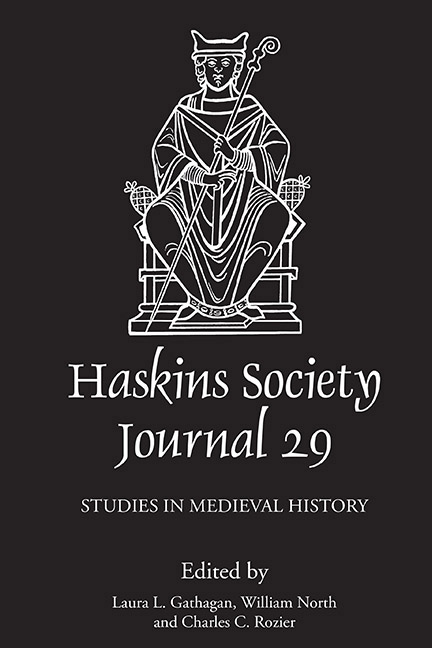Book contents
- Frontmatter
- Contents
- List of Figures and Tables
- Editors’ Note
- Abbreviations
- 1 The Longue Durée of a Symbolic System: Mounted Warriors and Horses in the Chronicon Salernitanum
- 2 Revolution(s) of Writing: Northern France, Tenth–Fourteenth Centuries
- 3 Slave or Free: The Aehtemann in Anglo-Saxon Rural Society
- 4 Norman Ducal Property in the Tenth and Eleventh Centuries: A Spatial and Chronological Analysis
- 5 The Codex Wintoniensis in its Twelfth-Century Context
- 6 The Carmen Ceccanense: A Neglected Source for the End of the Norman Kingdom of Sicily, Introduction – Edition – Translation
- 7 Succession and Interregnum in the English Polity: The Case of 1141
- 8 Crusading Participation in Normandy and its Borderlands: The Evidence from the Old French Traditions of the First Crusade
- 9 The Domesday Controversy: A Review and a New Interpretation
2 - Revolution(s) of Writing: Northern France, Tenth–Fourteenth Centuries
Published online by Cambridge University Press: 15 October 2019
- Frontmatter
- Contents
- List of Figures and Tables
- Editors’ Note
- Abbreviations
- 1 The Longue Durée of a Symbolic System: Mounted Warriors and Horses in the Chronicon Salernitanum
- 2 Revolution(s) of Writing: Northern France, Tenth–Fourteenth Centuries
- 3 Slave or Free: The Aehtemann in Anglo-Saxon Rural Society
- 4 Norman Ducal Property in the Tenth and Eleventh Centuries: A Spatial and Chronological Analysis
- 5 The Codex Wintoniensis in its Twelfth-Century Context
- 6 The Carmen Ceccanense: A Neglected Source for the End of the Norman Kingdom of Sicily, Introduction – Edition – Translation
- 7 Succession and Interregnum in the English Polity: The Case of 1141
- 8 Crusading Participation in Normandy and its Borderlands: The Evidence from the Old French Traditions of the First Crusade
- 9 The Domesday Controversy: A Review and a New Interpretation
Summary
Revolution and Revolutions
For many years, scholars have used the word ‘revolution’ when speaking about that moment in the transformation of the medieval world when suddenly the written word seems normal and the number of preserved documents steadily increases. This transformation began early, ostensibly in the eleventh and twelfth centuries, but probably – indeed, almost certainly – earlier still. In England, we encounter an impressive multiplication of documents in the twelfth and above all the thirteenth century, with its tens of thousands of surviving charters compared with the mere two thousand surviving English writs produced before 1066 or indeed the five thousand original French charters from before 1121. Yet, while the so-called revolution in writing may be accepted fact for the academic community, it has never been clearly defined. It has been characterized, since Clanchy's work, as an expansion or numerical explosion in conserved documents, not only in charters and cartularies but similarly in ‘literary’ and liturgical manuscripts in the second half of the twelfth century.
Numbers
Many researchers have already demonstrated the hold that writing had over thirteenth-century life where we see an unprecedented and, as yet, unequalled rate of documentary penetration as measured by surviving production. This can be easily seen from a simple graph enumerating the cartularies – collections of copies of charters made by their grantees and often keepers – preserved in French and Belgian archives (Figure 1). These cartularies were often a key component in an institution's archival administration and had been so since the tenth and eleventh centuries, if not indeed since the Carolingian period. Guardians of juridical memory, reservoirs of administrative practice, constructed sometimes of rich narrative detail, these cumulative documents have been studied above all as early medieval tools of commemoration, for in them was upheld the memoria (the memorial or ongoing remembrance) of the founders, the donors, the benefactors of the communities to which they belonged. But from the eleventh century, and especially during the twelfth and thirteenth centuries, the cartulary as administrative tool came into its own. From negligible numbers before 1100, they reach double figures for the twelfth century, then triple for the thirteenth (Figure 1). The cartulary became a relatively common tool and no longer something specific to particular religious communities such as the Cluniacs or the Cistercians.
- Type
- Chapter
- Information
- The Haskins Society Journal 292017. Studies in Medieval History, pp. 25 - 52Publisher: Boydell & BrewerPrint publication year: 2018



